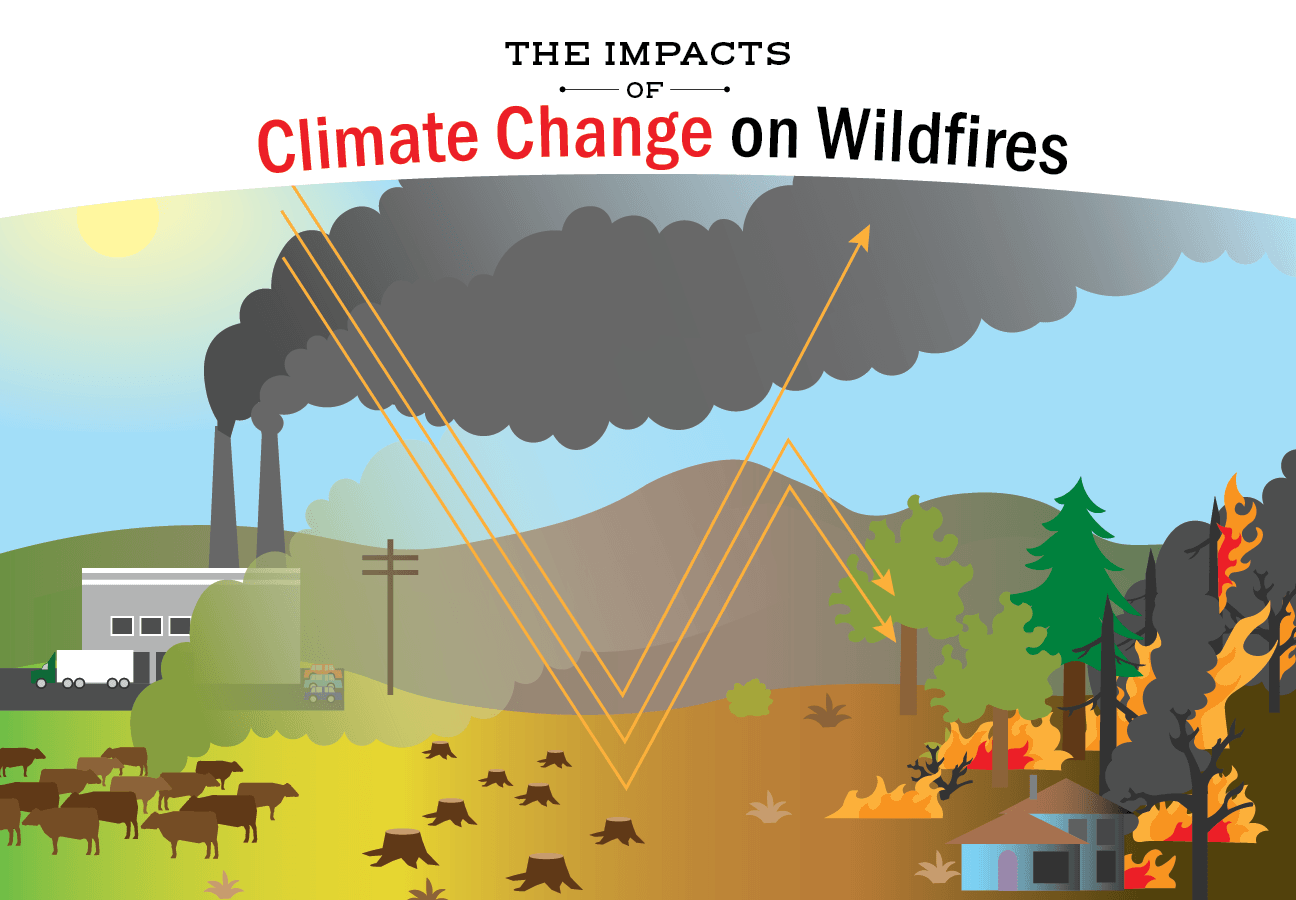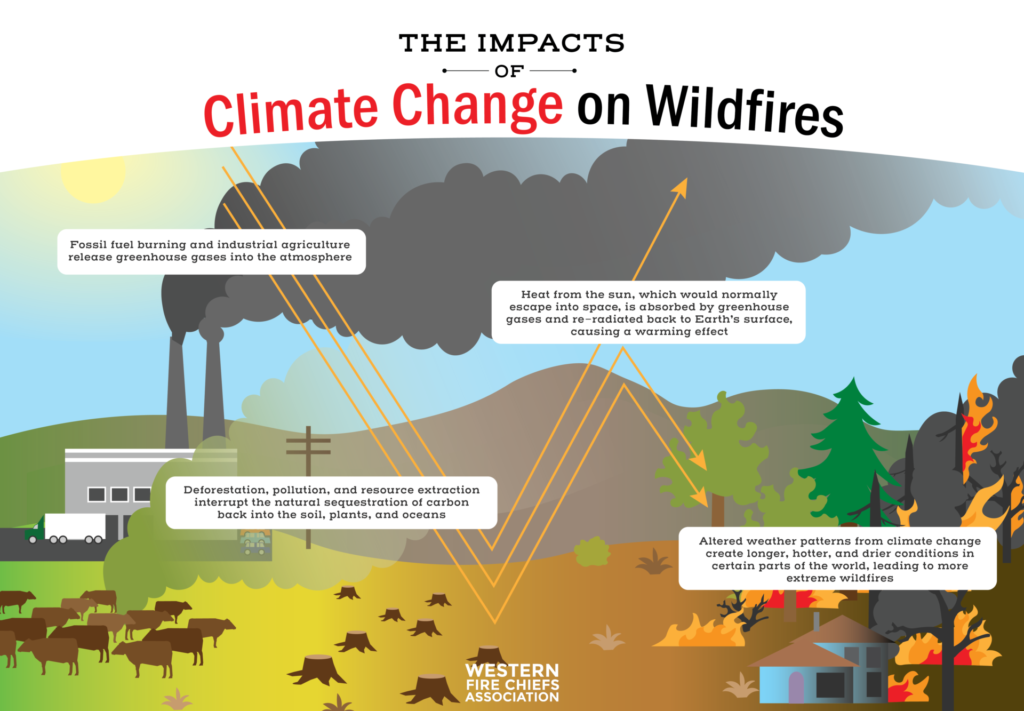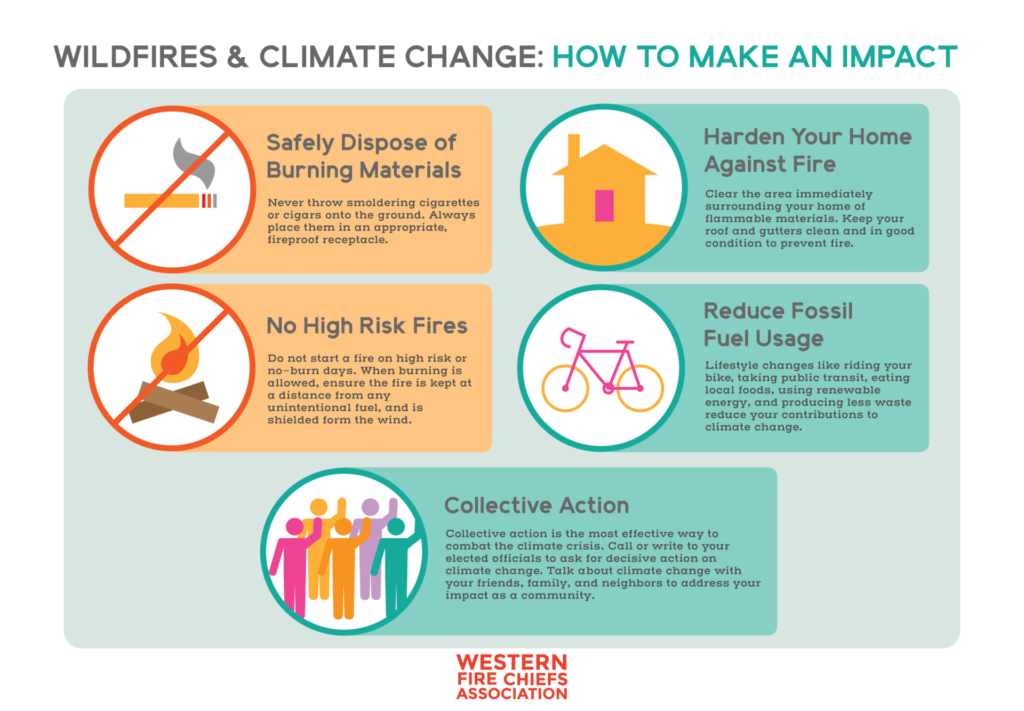Fire Pit Safety Tips
Stay safe around the campfire with tips from the Western Fire Chiefs Association. Learn essential precautions and practices for a worry-free outdoor campfire.
Explore the details of how wildfires and climate change are heavily intertwined with guidance and resources from the Western Fire Chiefs Association (WFCA).
Published:July 18, 2022
Edited:March 4, 2024

Are wildfires and climate change related? Wildfires are a natural part of many landscapes, and are essential for certain biological processes. However, a dramatic increase in the frequency and intensity of wildfires has been unfolding in recent years. Scientific evidence shows that there is a link between climate change and larger, more destructive fires.1
This article will discuss how climate change impacts weather, which drives more frequent and extreme wildfires. In conclusion, we will discuss what can be done to mitigate this dangerous cycle.
The current climate crisis is the result of decades of excessive fossil fuel burning. When fossil fuels are used to create heat and energy, heat-trapping gases, known as ‘greenhouse’ gases, are released into the atmosphere. The accumulation of greenhouse gases absorb heat that has been reflected off of Earth’s surface, which would otherwise escape into space. Instead, the gases transfer that heat back to Earth’s surface, creating a steady warming effect.2
The consequences of climate change are vast and complex. Your region may be getting hotter and drier, such as the Western United States, or you may be slammed with harsher, colder winters and historic floods, like many areas on the East Coast. Over-all, higher global temperatures interrupt weather patterns that have kept our planet stable and habitable for thousands of years.
Not all greenhouse gases are detrimental. Without human activities, the Earth has naturally produced the appropriate amount of greenhouse gases to form a protective barrier around the planet. This barrier (part of our atmosphere) helps keep the planet from losing too much heat to the vacuum of space.2
However, human-caused greenhouse gas emissions from factories, landfills, industrial farming, vehicles, etc., have hugely outpaced the Earth’s usual production. Additionally, deforestation and other resource-extraction activities have crippled the Earth’s ability to re-absorb carbon dioxide from the atmosphere and sequester it in forests, the ocean, and soil. Over-production of gases and simultaneous destruction of carbon-sinks has created an unbalanced cycle where far more greenhouse gases are produced than the Earth can functionally balance.3

As temperatures grow hotter and the air becomes drier because of climate change, wildfires occur more frequently. They also burn bigger and hotter.
This phenomenon unfolds for several reasons. One example is; as winter in the Western United States ends sooner and produces less snow, spring and summer snowmelt produce less water. Less surface and groundwater leads to the soil drying out, making plants more vulnerable and increasing the likelihood that a fire will start and spread.
Data from the National Interagency Fire Center suggests a correlation between climate change and wildfires. It shows there has been a proportional increase in the amount of acreage burned by wildfires with the rise in temperatures since 1983.
These points indicate that climate change is responsible for driving extreme growth in wildfires.
In addition to increased devastation from wildfires, global warming is also changing the accepted definition of fire season.
From 1982-2000, fire season peaked in August in the Western United States. Since 2001, however, it has peaked in July.4 It’s also lasting longer, research finds. The longer fire season is the natural result of shorter winters and longer summers, an imbalance caused by the warming effects of climate change.
Wildfires are not just a concern in California where the United States experiences its most intense fire season. In 2019 and 2020, Australia underwent a string of devastating wildfires that burned 46 million acres and killed an estimated 3 billion animals.5 That fire season lasted from July to March of the following year – eight long months. The World Wide Fund for Nature Australia called the wildfires “one of the worst wildlife disasters in modern history.”
Experts predict that global wildfires will only get worse. In a recent report released by the United Nations, researchers found that the likelihood of “extreme, catastrophic fires could grow 33% by 2050.6
Even areas of the world that are naturally colder, including the Arctic, Russia, and northern Europe will see an increase in wildfires in this scenario. In fact, the Arctic has already seen an uptick in fires. In the first decade of the 2000s, the Arctic saw 50% more acreage burned than it had in any decade of the 1900s.7

As individuals, there are many things we can do to improve this situation.
First, we can adopt best practices for preventing wildfires, such as:
Second, we can change the way that we contribute to carbon dioxide emissions and other greenhouse gases. By limiting CO2 emissions from the cars we drive, the ways we dispose of our trash, producing less waste, and using renewable energy as much as possible, we can lessen the impact of climate change on wildfire conditions.
Our real power is not as individuals, but as a collective. Reining in the biggest contributors to the climate crisis requires action at the legislative level. It will only happen if we make our voices heard. Consider writing to your elected officials to ask for decisive action in response to the climate crisis. Vote for representatives who will prioritize climate change, and who are not sponsored by major polluters. Talk about climate change with your friends, family, and neighbors, and take action to address your impact as a community.
The Western Fire Chiefs Association (WFCA) is committed to our role as advocates for the fire service, and we will continue to develop and promote cutting edge tools and technology to respond to the new age of wildfires.
Stay safe around the campfire with tips from the Western Fire Chiefs Association. Learn essential precautions and practices for a worry-free outdoor campfire.
Discover essential firework safety tips to ensure a dazzling display without accidents. Learn how to celebrate responsibly with expert guidance from WFCA.
Explore the role of AI in wildfire prediction with guidance from the WFCA. Learn how advanced algorithms and data analytics enhance early detection and response.